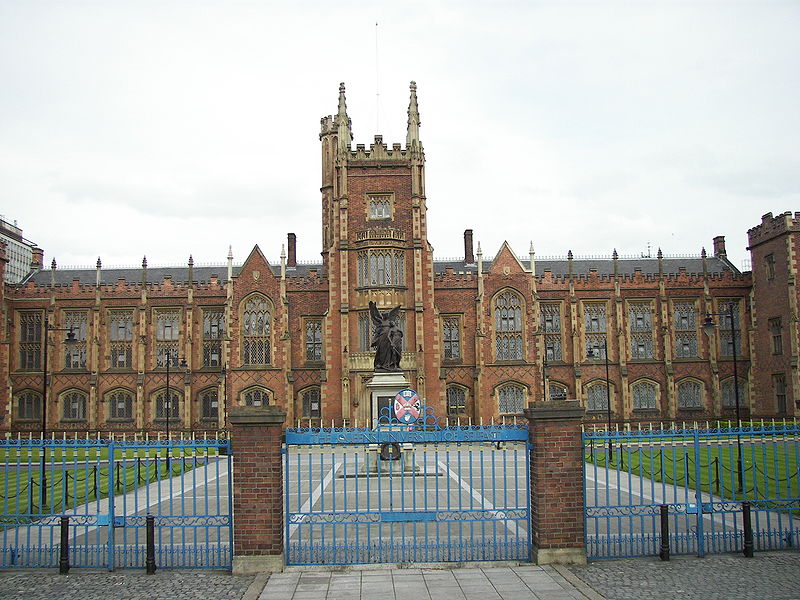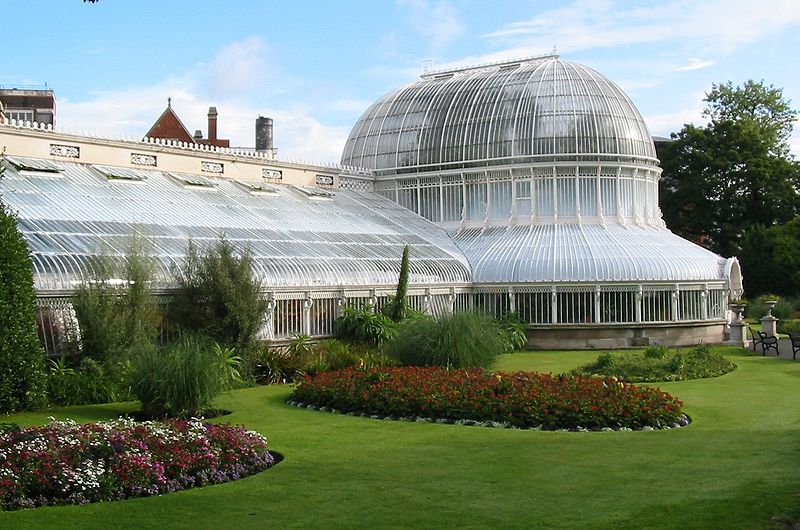Now firmly settled in peacetime living, Belfast loves visitors and knows how to treat them right. With its rich history, fun-loving folk, and international attitude, there’s plenty to do, no matter what time of year you visit.
You can play the culture vulture looking for symphonies and art galleries one day and take in a movie and a hot rock venue the next. Or you might favor bowling, golfing, or ice skating—or be wanting to Shop, Eat, Rest, and repeat. Whatever your interests, Belfast can do the job.

Titanic Signature Building, east Belfast. Adapted from Wikimedia Commons
Here are some ideas for fun things to do, the next time you’re in Ireland and decide to travel up to the capital of “Norn Iron” as the natives call it:
The Titanic Quarter: Make the Pilgrimage
Not a surprise that this one makes the list, but Belfast is, after all, the birthplace of the great if tragic ship of the White Star Line, built in the time when the Harland & Wolff shipyard was in its heyday. The Titanic Quarter is in east Belfast, easily reached by hopping one of the many buses that gather all day in the city centre, just to the right of the grand City Hall.
Make the easy pilgrimage to Titanic Belfast—it’s worth it. This huge venue houses nine galleries of interactive exhibits that are for nearly any age group. These include exact replicas of the Titanic’s cabins, grand staircase, and decks, archival film of her construction, and actual artifacts from the ship.
Also offered are an amazing nighttime sound and light show with fireworks, and the ‘Titanic Beneath’ experience, where visitors are surrounded by large-as-life high-def footage, projected onto screens that place you amid the underwater wreckage itself. Also to be enjoyed are Afternoon Tea by the Grand Staircase and an Ocean Exploration Centre, and much more. The Titanic Quarter itself offers boat tours, walking tours, a Titanic Pilgrimage walk, shopping, dining, and other attractions.
Different events are offered at different times, so check the website at http://www.titanicbelfast.com/Discover.aspx to see what’s on while you’re there.
Wandering the Cathedral Quarter
An easy walk from the city centre, this part of the city is named for the famous St. Anne’s Cathedral on Donegall Street, also known as Belfast Cathedral. Designed by architect Sir Thomas Drew and finished in 1904, this Anglican (Church of Ireland) church is known for its grand Romanesque architecture and impressive interior, replete with intricate tile mosaics, carved stonework, fine art, stained glass windows, and historical artifacts. Numerous visitors have raved over the beauty of its Christmas services and have high regard for its famous if oddly named “black Santa” charity tradition.

St Anne’s Cathedral, Belfast. Photo: Wikimedia Commons
The Cathedral Quarter also offers plenty of excellent eateries. Cafés and restaurants range from the nineteenth century elegance and opulence of the Merchant Hotel’s restaurant on Waring Street to the über-cool and modern 21 Social on Hill Street.
Gastro pubs include the famous and atmospheric John Hewitt at 51 Donegall Street, which offers live music—including traditional Irish—six nights a week. The locals will be happy to direct you to many other choices.
This creative quarter is also home to numerous arts festivals that take place at different times of the year. These include the Belfast Book Festival, the Belfast Pride Festival, Culture Night Belfast, Belfast City Blues Festival, Belfast Music Week, Belfast Comedy Festival, Belfast Children’s Festival, Belfast Film Festival, and Brilliant Corners Jazz Festival, among many others.
Best-known is the Cathedral Quarter Arts Festival. Held for 10 days in May each year, it is one of the city’s finest—and that’s saying a lot in a city of world class artists, writers, and performers. If you visit Belfast in May, don’t miss this festival.
This neighborhood is also home to some excellent photography galleries. Belfast Exposed at 23 Donegall Street, featuring both recent and archival photos, houses two galleries and a bookshop. For excellent photography exhibits on Belfast life, past and present, head for Red Barn Gallery at 43b Rosemary Street.
Contemporary art galleries include PS2 or Paragon Studios at 18 Donegall Street. Stop by Open Windows Productions at 25 Lower Donegall Street, where sculptor Anto Brennan displays his famous, uniquely Belfast-themed chess sets.
One of the largest galleries is the international Flax Art Studios at 44 Corporation Street, housing 17 studios in all. Belfast Print Workshop at 30 Waring Street is home to printmakers who also sell their creative work online and at the on-site gallery.
Explore Queen’s University and the Ulster Museum
Established as Queen’s College in 1845, this striking and impressive collection of neo-Gothic buildings stands proudly on University Road in south Belfast, about a 20-minute walk or five-minute bus ride from the city centre.
The university is home to 17,000 students, and is a vital part of the city’s historic, academic and cultural life. Queen’s is also home to the annual Belfast Festival, which takes place at numerous venues in and around the campus, the Queen’s Film Theatre, a great place for art house films, the Brian Friel Theatre, named after the North’s most famous playwright, and one of the country’s most renowned art galleries, the Naughton Gallery at Queen’s, which features both contemporary and historic art exhibits.

Photo: Wikimedia Commons: Wknight94
Tour the university’s grounds to take in the beauty of the architecture, gardens and sculpture, then spend an hour or so at the nearby Ulster Museum. This newly enlarged and refurbished museum offers wide-ranging exhibits, from dinosaur skeletons to Belfast linen factories to Ancient Egypt to fine art and beyond, including an ongoing array of temporary exhibits.
In good weather, enjoy the lush gardens and lawns of the adjacent Botanic Gardens and its charming Victorian Palm House, then enjoy afternoon tea, lunch or dinner at a nearby pub or restaurant.

Palm House, Botanic Garden. Photo: Wikimedia Commons: manvyi
Hitting the Clubs
Even if you’re not a natural partyer, Belfast clubs should be sampled for their glitz, glamour and fun. Café Vaudeville at 25 Arthur Street is one fun stop for its neo-classical décor alone. Chatter, munch and imbibe under its ritzy chandeliers and stained-glass dome, and enjoy the oldies tunes.
M Club at 23 Bradbury Place is a hot dance club, with deejays spinning techno, R&B and chart tunes depending on the night, and all the trendiest gear in evidence—in décor and fashion, both. Saturday nights are packed solid, so arrive before 10 PM.
The Limelight is connected to Katy Daly’s bar on the Ormeau Road in the city centre, and is likewise very popular and crowded on weekends, but worth it if you want to check out a great live rock venue that has featured a number of bands that have now reached stardom, including Oasis and Arctic Monkeys, among others.

Photo: Wikimedia Commons: Kenneth Allen
Pubs
The older Belfast pubs are full of history and atmosphere, and more than a few ghosts. A favorite among the locals (and they’ve got quite a few) is Bittles at 103 Victoria Street near Victoria Square. The over-40 crowd will appreciate this atmospheric and traditional nineteenth century bar, though the younger crowd favors it as the night wears on.
Mind your head at White’s Tavern. It’s Belfast’s oldest pub, dating back to 1630, with the low ceilings and stone floors to prove it. Located at 2 Winecellar Entry in the city centre, it offers a range of beers and ales on tap and traditional music on Saturday night in the Bottom Bar. A must-see for its history alone.
Lavery’s at Bradbury Place is a warren of bars and pubs, some offering live music. Choose whichever suits your mood at the time, from the Back Bar’s rock and roll to the Public Bar’s Retro Disco night. Or wander across the road, to Benedict’s, a unique bar/dance club with a gothic “ecclesiastical” décor.
Stop in for lunch at the Crown Liquor Saloon, a beautifully preserved Victorian pub at 46 Great Victoria Street. Featured in two films (John Wayne’s Odd Man Out (1947) and Divorcing Jack (1998)), this popular pub/restaurant hosts an ornate, wood-carved and Victorian-tiled interior with individual snugs, perfect for enjoying a glass of Guinness and a hot traditional meal of locally caught seafood or stew.
For more charm and tradition, head to The Garrick at 29 Chichester Street. Dating back to 1870, this famous pub offers an impressively wide range of beers and ales, traditional music on certain nights of the week, and a dance floor on Saturday nights—and no fee at the door.
There’s also a Belfast Pub Tour waiting to be sampled.
In Part Two, you'll discover Belfast theatre, more entertainment venues, and shopping - click here to read more.
Caroline Oceana Ryan is the Northern Ireland Editor for Wandering Educators, and Author, AN OLD CASTLE STANDING ON A FORD: One Yank’s Life in an Almost Peaceful Belfast (Eloquent Books, 2010) reviewed here, available on Amazon, to be re-released as an e-book in 2013 with the new title Adventures in Belfast: Northern Irish Life After the Peace Agreement.
